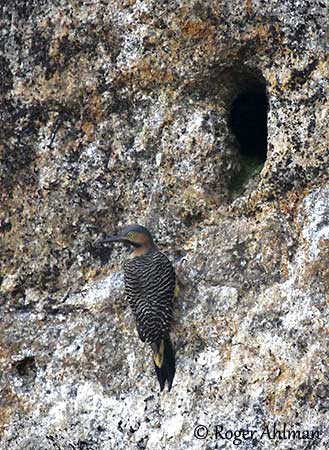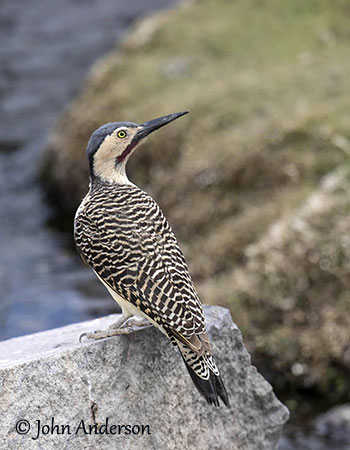
PROTECTION / THREATS / STATUS:
The Andean Flicker of race C.r. cinereicapillus is described as uncommon and local. The two other races are fairly common.
All populations are suspected to be stable and not globally threatened.
The Andean Flicker is currently evaluated as Least Concern.
Fr: Pic des rochers
Ang: Andean Flicker
All: Südandenspecht
Esp: Carpintero andino meridional
Ita: Picchio delle Ande
Nd: Andesgrondspecht
Sd: punaspett
Photographers:
Roger Ahlman
Pbase Galleries Peru and Ecuador & My bird pictures on IBC
John Anderson
John Anderson Photo Galleries
Didier Buysse
Vision d’Oiseaux
Jean Michel Fenerole
Photos d’Oiseaux du monde
Text by Nicole Bouglouan
Sources:
HANDBOOK OF THE BIRDS OF THE WORLD Vol. 7 by Josep del Hoyo-Andrew Elliott-Jordi Sargatal – Lynx Edicions – ISBN: 8487334377
Woodpeckers of the World: The Complete Guide by Gerard Gorman – Editeur: A&C Black, 2014 – Helm Photographic Guides - ISBN: 1408147173, 9781408147177
WOODPECKERS, an identification guide of the woodpeckers of the world by Winkler Hans and Christie David – Helm – ISBN: 0395720435
BIRDS OF PERU by Thomas S. Schulenberg, Douglas F. Stotz, Daniel F. Lane, John P. O’Neill, Theodore A. Parker III – Princeton University Press 2007– ISBN: 978-0-691-13023-1
Birdlife International (Southern Andean Flicker)
Birdlife International (Northern Andean Flicker)
HBW Alive (Southern Andean Flicker)
HBW Alive (Northern Andean Flicker)
Wikipedia, the free encyclopaedia
Neotropical Birds – Cornell Lab of Ornithology
Andean Flicker
Colaptes rupicola
Piciformes Order – Picidae Family
INTRODUCTION:
The Andean Flicker is a South American woodpecker. Three subspecies share the wide range from S Ecuador to Chile.
They frequent open land and forest edge, often at high elevations, between 2,000 and 5,000 metres.
This species feeds on insects and is highly terrestrial. Groups of several individuals can be seen foraging actively on the ground.
The Andean Flicker is described as fairly common, with some local declines.
DESCRIPTION OF THE BIRD:
Biometrics:
Length: 32-33 cm
Weight: 142-204 g
The Andean Flicker adult male of nominate race has barred brown, pale brown and buffish-white upperparts including wing-coverts and tertials. The flight-feathers are dark brown with narrow, pale buff bars. The rump is usually uniformly buffish-white, sometimes with a few bars, whereas uppertail-coverts are white and narrowly barred dark brown. The uppertail is black with finely barred central and outer rectrices.
On the cream to pale buff underparts, chin and throat are pale buffish-white, whereas the breast is slightly washed orange-buff, with blackish spotting or chevrons. These markings may extend to neck-sides and flanks. The undertail-coverts may show some short bars and the undertail is whitish, sometimes yellowish at sides. The underwing is pale buff-yellow, with darker wing tip and trailing edge, and the primary coverts may show some spots.

On the head, forehead to hindneck is dark slate-grey, slightly blacker on the sides. There is some red on the hindneck. The narrow, black malar stripe is tipped red (in male). Rest of face is pale buffish-white, slightly darker on ear-coverts.
The black bill is long and pointed, with broad base. The eyes are pale yellow. Legs and feet are greyish.
The female of nominate race lacks the red colour in the dark malar stripe and on the hindneck. She has shorter bill.
The juvenile is duller overall with buff nape. There is more barring on the underparts. The eyes are reddish-brown. The young male may have some red on the nape.
SUBSPECIES AND RANGE:
The Andean Flicker has three subspecies.
C.r. cinereicapillus occurs in extreme south of Ecuador (SE Loja) and N Peru. It was first recorded in Ecuador in early 1990s.
This race has darker, tan-buff face, throat and breast, whereas rump and belly are yellow-buff. There is no red on nape.
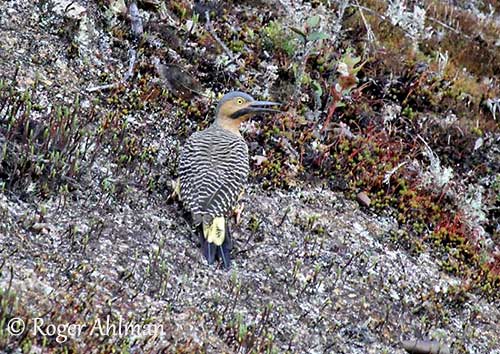
C.r. puna occurs in C and S Peru.
This one is darker than nominate above and below, and the breast markings are larger. Legs and feet are dull greenish. Both adults shows dark red patch on the hindneck.
Both C.r. cinereicapillus and C.r. puna meet in narrow hybrid zone in C Peru, north of Lake Junín.
C.r. rupicola (described above) occurs in W, C and S Bolivia, N Chile and NW Argentina.
HABITAT:
The Andean Flicker frequents high mountain areas with stones and rocky outcrops, scrub, grassland and alpine tundra. It is usually common in grassland of the Andean puna, but less common in the humid grass-shrubs of the páramo. It is also found in Polylepis woodlands. This species usually occurs between 2,000 and 5,000 metres of elevation.
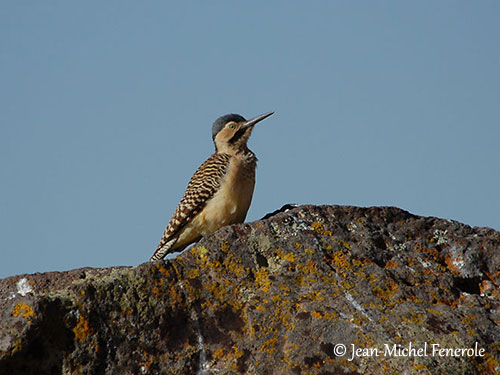
CALLS AND SONGS: SOUNDS BY XENO-CANTO
The Andean Flicker gives aa loud, piercing “kweeir” singly or in series “”Kleewk…Kleewk…Kleewk…” and we can also hear a fast “khE khE khE-khE” ending abruptly.
During the displays, it utters louder “kwa-kwa-kwa-wee-a, wee-a” and “Kway-ap”. A scolding sound is given in flight as alarm call. They drum very rarely, if at all.
Within the family groups, the birds communicate by constant chatter and various types of vocalisations.
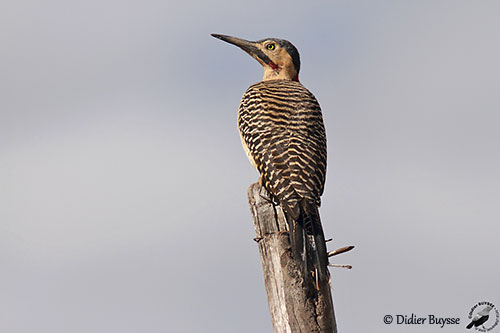
BEHAVIOUR IN THE WILD:
The Andean Flicker feeds mainly on insects and larvae caught on the ground. The bird sweeps away various debris with the bill, and probes into soil and clumps of grass. The diet includes insects and large lepidopteran and coleopteran larvae, but it also consumes beetles and moths.
It forages on the ground in steep, rocky or grassy terrains by walking or with hopping gait, stopping to probe into the soil with its long bill.
These gregarious birds often forage in groups of 8-10 individuals moving over long distances. The feeding areas may be at lower elevations and far from the roosts and the nesting sites.
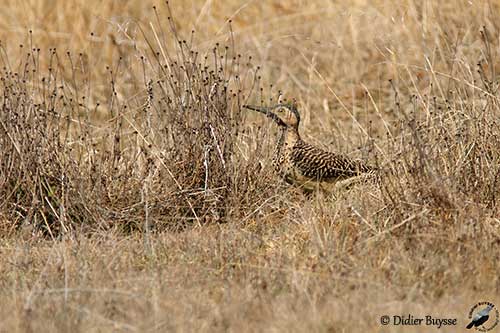
The Andean Flicker is a colonial breeder, and groups of 10 pairs or more can breed together, with nests sometimes only 50 centimetres apart. During the displays, the bird raises the head to vertical position, before to lower it. Wing-flicking, head- swinging with bobbing and tail-spreading are also part of courtship displays.
The Andean Flicker is resident, but some altitudinal movements usually occur, related to cold temperatures or snowy weather at high elevations.
Like in other Picidae, the flight is undulating.
REPRODUCTION OF THIS SPECIES:
The breeding season possibly occurs in September/November in C Peru, and from January to March elsewhere, but it probably breeds also at other times of the year.
The Andean Flicker digs a nest into earth banks, cliffs and rocky terrains, a horizontal or slightly upward-sloping entrance tunnel of about 1 metre long. The nest-chamber is at the end.
Small colonies of 10 pairs or more often share the same bank. However, some nests may be excavated in trees, especially Polypelis, but rarely.
The 2-4 chicks are fed by both parents. The nesting tunnel is cleaned by the adults that remove the faeces.
